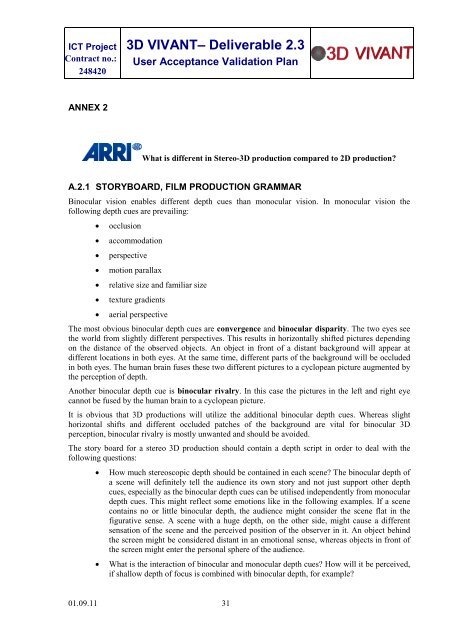DEliverable 2.3 - the School of Engineering and Design - Brunel ...
DEliverable 2.3 - the School of Engineering and Design - Brunel ...
DEliverable 2.3 - the School of Engineering and Design - Brunel ...
Create successful ePaper yourself
Turn your PDF publications into a flip-book with our unique Google optimized e-Paper software.
ICT Project 3D VIVANT– Deliverable <strong>2.3</strong><br />
Contract no.:<br />
248420<br />
User Acceptance Validation Plan<br />
ANNEX 2<br />
What is different in Stereo-3D production compared to 2D production<br />
A.2.1 STORYBOARD, FILM PRODUCTION GRAMMAR<br />
Binocular vision enables different depth cues than monocular vision. In monocular vision <strong>the</strong><br />
following depth cues are prevailing:<br />
• occlusion<br />
• accommodation<br />
• perspective<br />
• motion parallax<br />
• relative size <strong>and</strong> familiar size<br />
• texture gradients<br />
• aerial perspective<br />
The most obvious binocular depth cues are convergence <strong>and</strong> binocular disparity. The two eyes see<br />
<strong>the</strong> world from slightly different perspectives. This results in horizontally shifted pictures depending<br />
on <strong>the</strong> distance <strong>of</strong> <strong>the</strong> observed objects. An object in front <strong>of</strong> a distant background will appear at<br />
different locations in both eyes. At <strong>the</strong> same time, different parts <strong>of</strong> <strong>the</strong> background will be occluded<br />
in both eyes. The human brain fuses <strong>the</strong>se two different pictures to a cyclopean picture augmented by<br />
<strong>the</strong> perception <strong>of</strong> depth.<br />
Ano<strong>the</strong>r binocular depth cue is binocular rivalry. In this case <strong>the</strong> pictures in <strong>the</strong> left <strong>and</strong> right eye<br />
cannot be fused by <strong>the</strong> human brain to a cyclopean picture.<br />
It is obvious that 3D productions will utilize <strong>the</strong> additional binocular depth cues. Whereas slight<br />
horizontal shifts <strong>and</strong> different occluded patches <strong>of</strong> <strong>the</strong> background are vital for binocular 3D<br />
perception, binocular rivalry is mostly unwanted <strong>and</strong> should be avoided.<br />
The story board for a stereo 3D production should contain a depth script in order to deal with <strong>the</strong><br />
following questions:<br />
• How much stereoscopic depth should be contained in each scene The binocular depth <strong>of</strong><br />
a scene will definitely tell <strong>the</strong> audience its own story <strong>and</strong> not just support o<strong>the</strong>r depth<br />
cues, especially as <strong>the</strong> binocular depth cues can be utilised independently from monocular<br />
depth cues. This might reflect some emotions like in <strong>the</strong> following examples. If a scene<br />
contains no or little binocular depth, <strong>the</strong> audience might consider <strong>the</strong> scene flat in <strong>the</strong><br />
figurative sense. A scene with a huge depth, on <strong>the</strong> o<strong>the</strong>r side, might cause a different<br />
sensation <strong>of</strong> <strong>the</strong> scene <strong>and</strong> <strong>the</strong> perceived position <strong>of</strong> <strong>the</strong> observer in it. An object behind<br />
<strong>the</strong> screen might be considered distant in an emotional sense, whereas objects in front <strong>of</strong><br />
<strong>the</strong> screen might enter <strong>the</strong> personal sphere <strong>of</strong> <strong>the</strong> audience.<br />
• What is <strong>the</strong> interaction <strong>of</strong> binocular <strong>and</strong> monocular depth cues How will it be perceived,<br />
if shallow depth <strong>of</strong> focus is combined with binocular depth, for example<br />
01.09.11 31
















